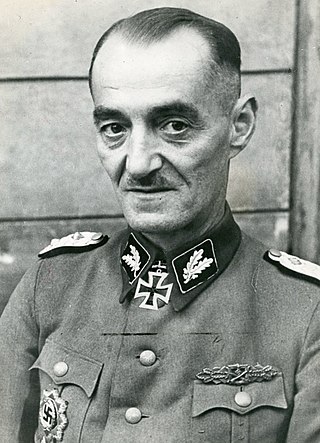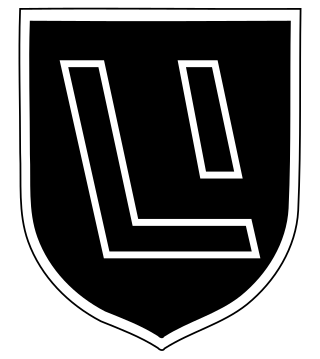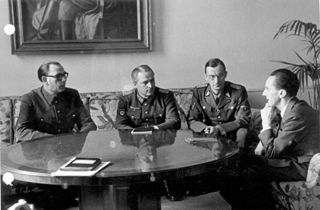
The Waffen-SS was the combat branch of the Nazi Party's paramilitary Schutzstaffel (SS) organisation. Its formations included men from Nazi Germany, along with volunteers and conscripts from both German-occupied Europe and unoccupied lands. It was disbanded in May 1945.

Gottlob Christian Berger was a senior German Nazi official who held the rank of SS-Obergruppenführer und General der Waffen-SS and was the chief of the SS Main Office responsible for Schutzstaffel (SS) recruiting during World War II. At the post-war Nuremberg trials, the Waffen-SS – within which Berger was a senior officer – was declared to be a criminal organisation due to its major involvement in war crimes and crimes against humanity. Berger was convicted as a war criminal and spent six and a half years in prison.

Oskar Dirlewanger was a German military officer (SS-Oberführer). He played a significant role as the founder and commander of the SS penal unit known as the "Dirlewanger" during World War II.

The Dirlewanger Brigade, also known as the SS-Sturmbrigade Dirlewanger (1944), or the 36th Waffen Grenadier Division of the SS, or The Black Hunters, was a unit of the Waffen-SS during World War II. The unit, named after its commander Oskar Dirlewanger, consisted of convicted criminals who were not expected to survive their service with the unit. Originally formed from convicted poachers in 1940 and first deployed for counter-insurgency duties against the Polish resistance movement, the brigade saw service in anti-partisan actions in German-occupied Eastern Europe.

The Wola massacre was the systematic killing of between 40,000 and 50,000 Poles in the Wola neighbourhood of the Polish capital city, Warsaw, by the German Waffen-SS and fellow Axis collaborators in the Azerbaijani Legion, as well as the predominantly-Russian RONA forces, which took place from 5 to 12 August 1944. The massacre was ordered by Heinrich Himmler, who directed to kill "anything that moves" to stop the Warsaw Uprising soon after it began.

Kaminski Brigade, also known as Waffen-Sturm-Brigade RONA, was a collaborationist formation composed of Russian nationals from the territory of the Lokot Autonomy in Axis-occupied areas of the RSFSR, Soviet Union on the Eastern Front.

The XV SS Cossack Cavalry Corps was a World War II cavalry corps of the Waffen-SS, the armed wing of the German Nazi Party, primarily recruited from Cossacks.

The Upper Rhine High Command, known for three days as Army Group Upper Rhine, was a short-lived headquarters unit of the German Armed Forces (Wehrmacht) created on the Western Front during World War II. The Upper Rhine High Command was formed on 26 November 1944 and deactivated on 25 January 1945. The sole commander of this headquarters unit was Heinrich Himmler.

The 30th Waffen Grenadier Division of the SS(1st Belarusian), originally called the 30th Waffen Grenadier Division of the SS , was a short-lived German Waffen-SS infantry division formed largely from Belarusian, Russian, Polish, and Ukrainian personnel of the Schutzmannschaft-Brigade Siegling in August 1944 at Warsaw in the General Government.

The 15th Waffen Grenadier Division of the SS , originally called the Latvian SS-Volunteer Division was an infantry division of the Waffen-SS during World War II. It was formed in February 1943, and together with its sister unit, the 19th Waffen Grenadier Division of the SS formed the Latvian Legion.

The Azerbaijani Legion was one of the foreign units of the Wehrmacht. It was formed in December 1941 on the Eastern Front as the Kaukasische-Mohammedanische Legion and was re-designated 1942 into two separate legions, the North Caucasian legion and the Azerbaijani legion. It was made up mainly of former Azerbaijani POW volunteers but also volunteers from other peoples in the area. It was part of the Ostlegionen. It was used to form the 162nd (Turkistan) Infanterie-Division of the Wehrmacht in 1943. similar to other Ostlegionen, it was organised to replenish the dwindling German manpower on the Eastern front and to "save the German blood at the front"

The 19th Waffen Grenadier Division of the SS was an infantry division of the Waffen-SS during World War II. It was the second Latvian division formed in January 1944, after its sister unit, the 15th Waffen Grenadier Division of the SS with which it formed the Latvian Legion. It was surrounded in the Courland Pocket at the end of the war where it surrendered to the Red Army.
The 18th SS Volunteer Panzer Grenadier Division "Horst Wessel" was formed in 1944 around a cadre from the 1st SS Infantry Brigade and included mainly ethnic Germans (Volksdeutsche) from Hungary. The 1st battalion of about 1000 men was attached to SS Division Horst Wessel and sent to Galicia.

During World War II, the Waffen-SS recruited significant numbers of non-Germans, both as volunteers and conscripts. In total some 500,000 non-Germans and ethnic Germans from outside Germany, mostly from German-occupied Europe, were recruited between 1940 and 1945. The units were under the control of the SS Führungshauptamt beneath Reichsführer-SS Heinrich Himmler. Upon mobilisation, the units' tactical control was given to the Oberkommando der Wehrmacht.

Among the approximately one million foreign volunteers and conscripts who served in the Wehrmacht during World War II were ethnic Belgians, Czechs, Dutch, Finns, Danes, French, Hungarians, Norwegians, Poles, Portuguese, Swedes, Swiss along with people from Great Britain, Ireland, Estonia, Latvia, Lithuania, and the Balkans. At least 47,000 Spaniards served in the Blue Division.
The Panzer Division Jüterbog was an armoured division of the Wehrmacht during World War II. Created on 20 February 1945, it was active for a short period of time.
The CI Army Corps, alternatively also referred to as Roman 101st Corps, was a corps-level unit of the German Wehrmacht during World War II. It existed only for a few months during the year 1945.
The 270th Infantry Division was an infantry division of the German Heer during World War II.
The 2nd Cossack Cavalry Division was a short-lived cavalry division of Nazi Germany's Waffen-SS during World War II. The division existed from November 1944 until May 1945. It was one of two Waffen-SS Cossack divisions, along with the 1st Cossack Cavalry Division.














